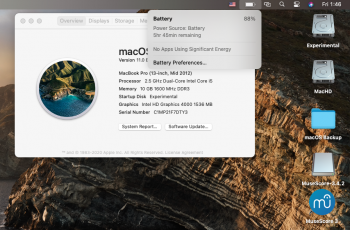Oh Great @jackluke, awesome !!! So now we have many ways to boot macOS 11, yours is legacy one so helpfulBreaking news: I discovered a way to boot BigSur without Opencore using the legacy prelinkedkernel instead of the new BootKernelExtensions.kc , here are the steps:
diskutil apfs listto identify your UUID-BigSur unique Preboot Volume string.
diskutil mount Preboot
or mount your BigSur Preboot Volume (it works also from HighSierra, Mojave, Catalina or directly from BigSur)
open /Volumes/Preboot/
check that in your UUID-BigSur folder is present this: /System/Library/PrelinkedKernels/prelinkedkernel
current BigSur beta 1 prelinkedkernel size: 25,7 MB
locate this path : /Volumes/Preboot/UUID-BigSur/System/Library/CoreServices/com.apple.Boot.plist
if you don't have the file then consider to replace it also in this path:
/Volumes/Preboot/UUID-BigSur/Library/Preferences/SystemConfiguration/com.apple.Boot.plist
edit the file exactly this way:
Code:<?xml version="1.0" encoding="UTF-8"?> <!DOCTYPE plist PUBLIC "-//Apple//DTD PLIST 1.0//EN" "http://www.apple.com/DTDs/PropertyList-1.0.dtd"> <plist version="1.0"> <dict> <key>Kernel Cache</key> <string>System\Library\PrelinkedKernels\prelinkedkernel</string> <key>Kernel Flags</key> <string>-no_compat_check amfi_get_out_of_my_way=1</string> </dict> </plist>
At next reboot your BigSur installation will use the prelinkedkernel
@ASentientBot and @dosdude1 might find this useful for their BigSur patches.
edit:
The same method can apply also to USB BigSur Installer, because it is still present also there on
/Volumes/USBInstallerBigSur/System/Library/PrelinkedKernels/prelinkedkernel
so just redirecting the /Volumes/USBInstallerBigSur/Library/Preferences/SystemConfiguration/com.apple.Boot.plist
adding to it <key>Kernel Cache</key> with <string>System\Library\PrelinkedKernels\prelinkedkernel</string> will override the default BaseSystem.dmg (ramdisk) BootKernelExtensions.kc and legacy prelinkedkernel is used.
Code:<?xml version="1.0" encoding="UTF-8"?> <!DOCTYPE plist PUBLIC "-//Apple//DTD PLIST 1.0//EN" "http://www.apple.com/DTDs/PropertyList-1.0.dtd"> <plist version="1.0"> <dict> <key>Kernel Cache</key> <string>System\Library\PrelinkedKernels\prelinkedkernel</string> <key>Kernel Flags</key> <string>root-dmg=file:///BaseSystem/BaseSystem.dmg -no_compat_check keepsyms=1 cs_enforcement_disable=1 cs_debug=1 amfi_allow_any_signature=1 amfi_get_out_of_my_way=1</string> </dict> </plist>
I attach the two files, I added many nvram boot-args for testing purpose.
Thank You
@Barry K. Nathan go ahead man with your patcher we are here to test them all!
All the best our Devs ❤️ 👍
Last edited:




 but the usual boot loading bar would not appear.
but the usual boot loading bar would not appear.